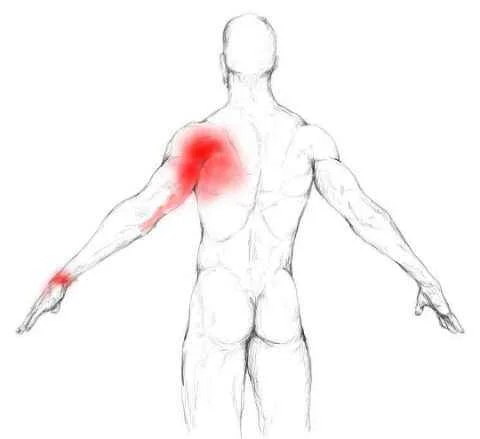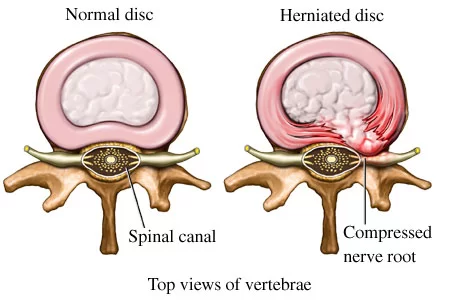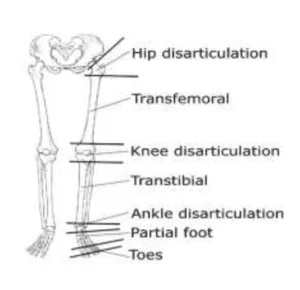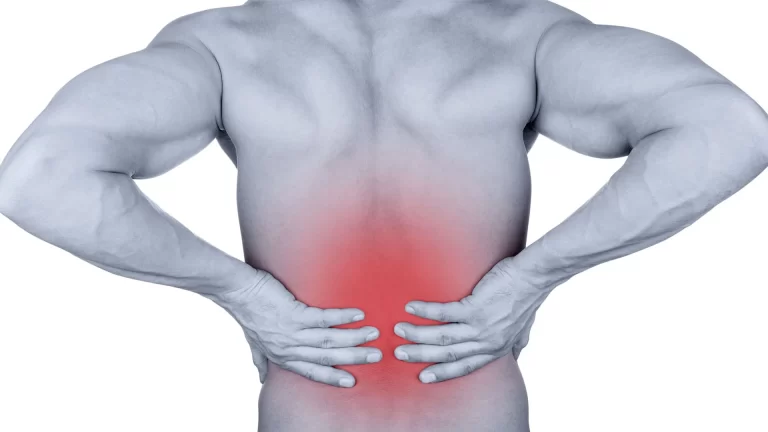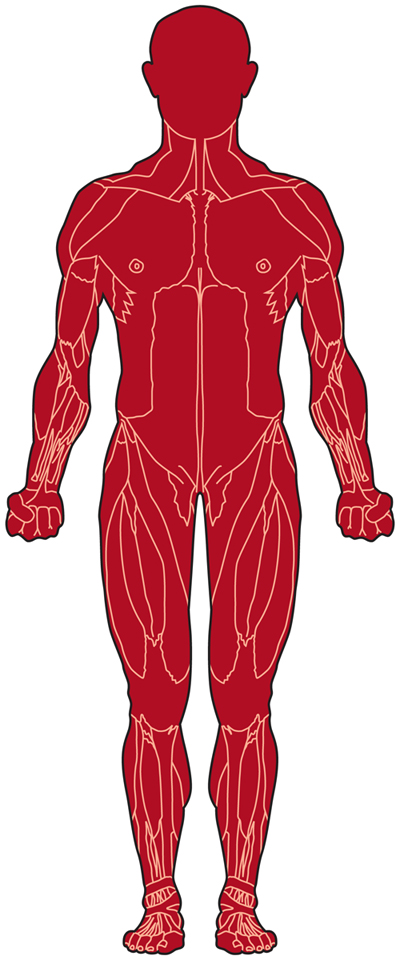Subscapularis Muscle Pain
Table of Contents
What is the Subscapularis Muscle Pain?
Subscapularis muscle pain can arise due to a variety of factors, including overuse, poor posture, sudden trauma, or underlying medical conditions such as tendonitis or rotator cuff tears. The discomfort associated with subscapularis muscle pain can range from mild to severe, impacting daily activities and diminishing overall quality of life.
The stability of the shoulder as a whole as well as the internal rotation of the arm depends on the subscapularis, which is located on the underside of the shoulder blade.
Despite its importance, the subscapularis muscle can become unpleasant for various reasons, such as overuse, injury, and stress.
Usually located deep within the shoulder joint or at the front of the shoulder, this type of discomfort can also be accompanied by weakness or a limited range of motion.
For those seeking comfort and efficient shoulder care, knowing the origins, symptoms, and possible treatments of subscapularis muscle pain is vital.
The subscapularis muscle is a vital shoulder muscle. This research will cover its anatomy, typical causes of discomfort, indications, and management and prevention techniques for this muscle.
Related Anatomy
The subscapularis muscle is one of the four muscles that make up the rotator cuff, which is a group of tendons and muscles that surround the shoulder joint and provide support and movement.
Below is an overview of the pertinent anatomy:
Location:
The subscapularis muscle is situated on the scapula’s front (front) surface, or shoulder blade.
It runs from the subscapular fossa, a concave depression on the front side of the scapula, to the lesser tubercle of the humerus, a bony protrusion on the upper part of the arm bone.
Origin and Insertion:
The muscle starts in the subscapular fossa.
Its tendon is attached to the lesser tubercle of the humerus
Function:
The primary mechanism for medially moving the arm at the shoulder joint is the subscapularis.
In addition, it aids in stabilizing the shoulder joint, particularly during activities that include a lot of overhead movement.
Innervation:
The subscapularis is innervated by the upper and lower subscapular nerves, which are branches of the brachial plexus.
Understanding the anatomy of the subscapularis muscle is crucial to understanding how it works in the shoulder and any potential repercussions for pain or dysfunction.
The general stability and range of motion of the shoulder joint can be impacted by subscapularis issues or injuries, which can cause discomfort, weakness, and limited mobility.
Causes of Subscapularis Muscle Pain
One of the four muscles that make up the shoulder’s rotator cuff is the subscapularis muscle. It is essential to the stability and range of motion of the shoulder joint. There are several possible causes of subscapularis muscle discomfort, therefore it’s critical to determine the underlying reason to receive the appropriate care.
Several typical reasons for discomfort in the subscapularis muscle include:
Overuse or Repetitive Strain:
The subscapularis muscle may become overused or strained as a result of repetitive overhead motions or shoulder-related activities. Athletes frequently experience this, especially those who participate in weightlifting, baseball, or swimming.
Muscle Imbalances:
Unbalances in the strength and flexibility of the muscles around the shoulder joint can increase pain and place more strain on the subscapularis.
Erroneous alignment, particularly when the shoulders are hunched forward, may lead to postural instability and stress on the subscapularis muscle.
Trauma or Injury:
A fall hit or dislocation is an example of direct trauma or injury to the shoulder that can harm the subscapularis muscle and produce discomfort.
Rotator Cuff Tears:
Pain can result from tears in the subscapularis muscle, which is part of the rotator cuff. Rotator cuff tears can result from long-term degenerative changes or from sudden trauma.
Muscle Imbalances
Pain and increased stress can result from weakness or abnormalities in the muscles around the shoulder, particularly the subscapularis.
Referred Pain:
Sometimes there is pain in the subscapularis area that comes from other structures in the shoulder or neck. For instance, referred pain may be brought on by problems with the cervical spine or the nearby nerves.
Inflammation
The subscapularis muscle can be impacted by inflammatory diseases such as tendinitis or bursitis, which can cause discomfort, swelling, and a decrease in range of motion.
Nerve Compression:
Subscapularis discomfort can result from compression or irritation of the brachial plexus, one of the nerves that surround the shoulder.
Arthritis:
Subscapularis muscle discomfort can be attributed to degenerative changes in the shoulder joint, such as osteoarthritis or rheumatoid arthritis.
Poor Biomechanics:
Inappropriate biomechanics or flawed movement patterns during an activity can put strain on the subscapularis muscle, which over time can cause discomfort.
Symptoms of Subscapularis Muscle Pain
Depending on the underlying reason, a range of symptoms, varied in shape and intensity, may accompany subscapularis muscle soreness.
The following are typical signs of discomfort in the subscapularis muscle:
Shoulder Pain:
One typical sign of dysfunction in the subscapularis muscle is soreness or discomfort felt at the front of the shoulder or deep within the shoulder joint.
Pain with Movement:
Certain actions, particularly those involving internal rotation of the arm or elevating the arm, may make pain worse.
Weakness:
One may feel weak in the afflicted shoulder, especially while performing exercises that use the subscapularis muscle.
Limited Range of Motion:
People may experience a reduction in shoulder range of motion, especially with internal rotation.
Shoulder Stiffness:
Affected subscapularis muscles can cause stiffness in the shoulder joint, particularly in the morning or after periods of inactivity.
Pain at Rest:
Certain people may feel discomfort when they’re at rest, especially if their subscapularis muscle is irritated or inflamed.
Radiating Pain:
There might be soreness or sensitivity to pressure on the subscapularis muscle or its surrounding region.
Tenderness to Touch:
There might be soreness or sensitivity to pressure on the subscapularis muscle or its surrounding region.
Painful Activities:
Activities like reaching, lifting, and carrying objects might result in or worsen pain in the subscapularis muscle.
Night Pain:
Some people may feel more pain or discomfort at night, especially if they’re lying on the shoulder that’s been injured.
It’s important to remember that these symptoms might mimic those of other shoulder problems, so a thorough assessment by a medical specialist is necessary to get a precise diagnosis.
Seeking quick medical attention can assist in identifying the underlying source of the symptoms and direct the development of effective relief and rehabilitation treatment plans.
Differential Diagnosis
Subscapularis muscle soreness is a common symptom of several shoulder diseases.
A correct diagnosis will be reached by a healthcare expert after a thorough evaluation.
The following differential diagnoses are a few to think about:
The symptoms of one rotator cuff injury may potentially affect other rotator cuff muscles.
Shoulder Impingement Syndrome:
Compression of the tissues between the acromion, a component of the shoulder blade, and the humeral head can cause pain, especially while performing overhead motions.
Frozen Shoulder (Adhesive Capsulitis):
This condition produces stiffness and pain in the shoulder joints by limiting the range of motion.
It can be related to inflammation of the synovial lining.
Labral Tears:
The cartilage that surrounds the shoulder socket, the labrum, is prone to ripping and producing discomfort. It may also have anything to do with instability.
Bicipital Tendinitis:
Anterior shoulder discomfort may result from inflammation of the biceps tendon’s long head, which passes through the shoulder joint.
Cervical Radiculopathy:
Shoulder disorders may mimic pain that radiates to the shoulder area as a result of nerve irritation or compression in the cervical spine of the neck.
Osteoarthritis of the Shoulder:
Pain, stiffness, and a reduction in range of motion are possible outcomes of shoulder joint degeneration.
Thoracic Outlet Syndrome:
Shoulder and arm discomfort may result from compression of blood vessels or nerves as they travel through the thoracic outlet.
Referred Pain from Internal Organs:
There are times when illnesses like gallbladder disease or heart-related problems might be connected to shoulder pain.
Infectious or Inflammatory Conditions:
An infection or inflammation of the shoulder joint may occur in cases of septic arthritis or rheumatoid arthritis.
Tendonitis or Tendinopathy:
Other than the subscapularis tendon, other shoulder tendons may become inflamed or degenerate, leading to discomfort and functional restrictions.
To accurately diagnose these conditions, a complete physical examination, diagnostic injections, and imaging techniques (MRI, X-rays) can all be employed.
Individuals who are having shoulder pain should see a doctor for a thorough assessment and the right treatment.
Diagnosis
A medical practitioner must do a thorough examination to diagnose subscapularis muscle discomfort.
The following are the main elements and phases of the diagnostic process:
Medical History:
The healthcare professional will ask about the patient’s medical history, including the onset of symptoms, any specific accidents or injuries, and details regarding the kind and progression of the pain.
Physical Examination:
A thorough physical examination will be performed, paying particular attention to the shoulder and its supporting structures.
The healthcare provider will assess the range of motion, strength, and any signs of edema or pain.
Clinical Tests:
Clinical tests including the Internal Rotation Lag Sign, Belly Press Test, and Lift-Off Test may be performed to assess the health and performance of the subscapularis muscle.
Imaging Studies:
MRIs (Magnetic Resonance Imaging) and X-rays are imaging methods that may be used to view the shoulder joint, muscles, and soft tissues.
These can be utilized to find structural abnormalities, inflammation, or tears.
Diagnostic Injections:
For diagnostic purposes, a local anesthetic or anti-inflammatory medication injection may be used sometimes.
Finding out if the subscapularis muscle is implicated might be feasible if the injection momentarily cures the symptoms.
Laboratory Tests:
To rule out infections or systemic illnesses that might be a factor in shoulder discomfort, blood tests may be prescribed.
Differential Diagnosis:
Using a process of elimination, the healthcare professional will take into account and rule out further possible reasons for shoulder discomfort.
Comparing symptoms and results with those of different shoulder disorders may be necessary for this.
Specialized Consultations:
Depending on the complexity of the case, the healthcare professional may confer with specialists such as physical therapists or orthopedic surgeons to assist with diagnosis and therapy planning.
Patient Input:
It is critical to acquire the patient’s input on the kind, severity, and underlying causes of their pain.
Any relevant information provided by the patient might help to speed up the diagnosis process.
Those experiencing shoulder discomfort should seek medical attention as soon as possible for an accurate diagnosis.
Once a diagnosis has been made, the physician can design a customized treatment plan that may include physical therapy, medication, rest, or, in some cases, surgery.
A timely and accurate diagnosis can have a significant impact on the efficacy of the chosen treatment plan.
Treatment of Subscapularis Muscle Pain
The optimal course of treatment for subscapularis muscle pain depends on its underlying etiology and severity.
Typical treatments for subscapularis muscle soreness include the following:
Rest and Activity Modification:
Resting the shoulder adequately and avoiding activities that aggravate pain will hasten the healing process.
Changes to activities that involve repetitive shoulder movements or excessive strain on the subscapularis muscle are often recommended.
Ice and Heat Therapy:
Applying ice packs to the injured shoulder may help reduce inflammation and alleviate pain.
One type of heat treatment that may help reduce muscle tension and improve blood flow is using warm compresses.
Nonsteroidal Anti-Inflammatory Drugs (NSAIDs):
Over-the-counter NSAIDs, including ibuprofen or naproxen, can help reduce pain and inflammation.
Meanwhile, a doctor has to keep a careful eye on and oversee their continuous use.
Physical Therapy:
A physical therapist can design a personalized training plan to strengthen, balance, and realign any abnormalities in the shoulder muscles.
There can be specific exercises that target the subscapularis muscle.
Corticosteroid Injections:
To aid with pain management and inflammation reduction in cases of severe inflammation, a physician may choose to inject corticosteroids into the surrounding tissue or the subscapularis tendon.
Ultrasound or Electrical Stimulation:
These techniques can be used in physical therapy to relieve pain, reduce inflammation, and accelerate healing.
Activity Gradual Resumption:
When symptoms begin to improve, a healthcare professional might advise a gradual return to regular activities and exercise to prevent recurrence.
Orthopedic Intervention:
When there is significant damage or persistent discomfort, surgery may be recommended.
This may mean fixing a torn subscapularis tendon or attending to underlying structural issues.
Postural Correction:
For long-term care, posture has to be corrected if it is determined to be a contributing factor.
Making ergonomic adjustments and engaging in posture-correcting activities may be suggested.
Physiotherapy Treatment of Subscapularis Muscle Pain
Physiotherapy aims to improve function, reduce pain, and prevent the recurrence of subscapularis muscle soreness.
A physiotherapist will design a personalized treatment plan based on the patient’s needs and unique circumstances.
The following are typical physiotherapy interventions for subscapularis muscle discomfort:
Assessment:
The physiotherapist will do a thorough assessment, which can comprise a thorough history, a physical examination, and imaging results.
This helps identify the source and degree of soreness in the subscapularis muscle.
Pain Management:
Using techniques like heat or cold therapy can aid in reducing inflammation and managing pain.
Range of Motion
Simple exercises to maintain and extend the range of motion in the shoulder joints.
Passive and active assisted exercises may be used to gradually recover flexibility.
Strengthening
exercises intended especially to strengthen the subscapularis and other shoulder girdle muscles.
Depending on the participant’s tolerance and recovery capacity, the program’s exercises may alternate between isometric and isotonic.
Postural Correction:
Teaching proper posture and ergonomics to reduce shoulder joint discomfort and prevent more issues.
Manual Therapy:
Manual treatments such as massage, joint mobilizations, and soft tissue mobilizations can be used to release tension in the muscles, improve circulation, and hasten the healing process.
Stretching
Specific stretches to improve the flexibility of the subscapularis muscle and the surrounding tissues.
Neuromuscular Re-education:
Workouts and activities aimed at enhancing the coordination and control of the shoulder muscles to increase their overall stability.
Functional Training:
Consisting of exercises that mimic daily chores or specific sports movements to ensure a smooth transition back to normal activity.
Home Exercise Program:
To sustain the gains obtained during physiotherapy sessions, they provide a structured at-home exercise program that individuals may undertake independently.
Progressive Loading:
Strength and stability may be increased through exercise by progressively increasing the intensity and difficulty of the movements without overtaxing the body.
Patient Education:
Instructing the patient on how to prevent injuries, proper body mechanics, and their sickness.
Monitoring and Adjustments:
Physiotherapy is often the safe and effective way to relieve discomfort in the subscapularis muscle. Patients must participate fully in their therapy and keep lines of communication open with their physiotherapist to optimize outcomes.
Exercises
The following exercises might help relieve discomfort in the subscapularis muscle. Before beginning any exercise program, it is important to speak with a medical expert or a licensed physiotherapist. They may offer tailored advice depending on the patient’s unique condition and recovery stage:
Towel Stretch
A useful and rather easy exercise for lengthening the Subscapularis muscle is the towel stretch.
Depending on how comfortable it is for you, start by sitting or lying down on the ground and holding a towel tightly in both hands.
Wrap one end of the towel over your forearm just below your elbow, bending it to a 90-degree angle.
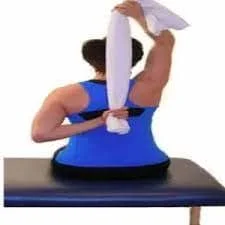
Draw yourself as far away from it as you can by holding onto the other end of the towel. A constant, mild stretch should be felt across your shoulder region.
You will quickly experience the advantages of the stretch, which include increased mobility, a reduction in localized pain and discomfort, and an extension of your range of motion. Hold this posture for 15 to 30 seconds, and then repeat with your other arm.
External Rotation Exercise:
For this workout, use a cable machine or a resistance band.
Put the band or cable in place at the waist.
With your Infected hand, hold onto the band or handle while standing sideways to the anchor point.
As you spin your arm outward against the opposition, keep your elbow at your side.
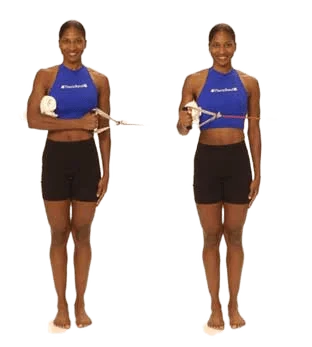
Take a seat or stand with proper posture.
As though you were attempting to pinch something between your shoulder blades, compress them together tightly.
Repeat 10–15 times while holding for 5–10 seconds.
Yoga Child’s Pose:
If you have identified any muscular imbalances or weaknesses, include corrective workouts in your schedule with the assistance of a physiotherapist or fitness professional.

You may lower your chance of developing subscapularis muscle soreness and preserve the best possible health for your shoulders by implementing these preventive steps into your everyday routine. It is best to get individual advice from a licensed physiotherapist or medical expert if you have a history of shoulder problems or issues.
How to Prevent Subscapularis Muscle Pain
Making lifestyle adjustments, keeping good shoulder mechanics, and including exercises to strengthen and stretch the muscles surrounding the shoulder joint are all important in preventing subscapularis muscle soreness. Here are a few precautions to take:
Maintain Good Posture:
Maintain good posture by angling your shoulders backward. To lessen the strain on the shoulder muscles, try not to decrease.
Ergonomics:
Test the comfort of the space where you operate. Chair and computer height adjustments might help you maintain proper posture and avoid putting undue pressure on your shoulders.
Warm-Up Before Activity:
Before beginning any activity that requires heavy lifting or repetitive shoulder motions, warm up properly. This aids in getting the muscles ready for more action.
Avoid Overuse
Watch out for recurrent shoulder motions, particularly those that include internal rotation. To keep the subscapularis muscle from being overused, take breaks and switch.
Proper Lifting Techniques:
Use safe lifting practices while moving goods. Keep the thing near to your body, bend at the knees, and refrain from reaching or twisting excessively.
Cross-Training:
Take part in a range of physical activities to avoid overusing any particular muscle group. By distributing the burden and lowering the chance of overuse problems, cross-training can be beneficial.
Maintain a Healthy Lifestyle:
To lessen undue strain on the joints, eat a balanced diet and keep a healthy weight. To support general muscular function, drink plenty of water.
Regular Physical Activity:
Frequent exercise supports the general health of your muscles and joints. Make sure your routine includes aerobic, strength, and flexibility activities.
Listen to Your Body:
Keep an eye out for any indications of shoulder pain or discomfort. Consult a doctor right away if your symptoms are severe or persistent.
Stay Hydrated:
To keep muscles and joints healthy, one must drink enough water. It supports general joint function and aids in the prevention of stiffness.
Conclusion
In conclusion, shoulder function and general health can be greatly impacted by subscapularis muscle soreness. For those looking for relief from this ailment, it is essential to comprehend the anatomy, causes, symptoms, and available treatments. Regardless of whether the discomfort stems from strain, overuse, or underlying shoulder problems, a thorough approach to diagnosis and treatment is crucial.
A medical practitioner, such as a doctor or physical therapist, can do a comprehensive assessment to identify the precise source of discomfort in the subscapularis muscle. A physical examination, imaging investigations, medical history, and, in certain situations, diagnostic injections may all be part of the diagnostic procedure.
Combinations of physical therapy, exercises, rest, and, in certain situations, medication or surgery are common treatment methods. Physiotherapy, which focuses on strengthening, stretching, and enhancing general shoulder function, is essential during the healing process.
Subscapularis muscle soreness may be avoided in large part by practicing preventive care, which includes proper posture, suitable exercise, and awareness of shoulder mechanics. The general health of the shoulder is influenced by appropriate ergonomics, a healthy lifestyle, and regular physical exercise.
In the end, those who are having discomfort in the subscapularis muscle should consult a doctor as soon as possible for a precise diagnosis and customized care. Through the use of preventative techniques and treating the underlying cause, individuals can strive to preserve good shoulder function and avert subsequent bouts of pain and discomfort.
FAQ
One of the four muscles that make up the shoulder’s rotator cuff is the subscapularis muscle. Its main purpose is to medially rotate the arm and support the stability of the shoulder as a whole.
Numerous problems, including tendinitis, bursitis, rotator cuff tears, trauma, overuse, muscular imbalances, poor posture, and frozen shoulder, can cause discomfort in the subscapularis muscle.
There might be soreness to the touch, weakness, restricted range of motion, discomfort deep inside the joint or at the front of the shoulder, and pain that gets worse with certain activities.
A medical practitioner’s thorough assessment, which includes a patient’s medical history, physical examination, imaging tests (MRIs and X-rays), and, in certain situations, diagnostic injections, is required to provide a diagnosis.
In extreme situations, surgical intervention may be necessary in addition to rest, ice or heat therapy, NSAIDs, physical therapy, exercises, and injections of corticosteroids.
Exercises like wall angels, pendulums, external rotations, isometric contractions, and stretching exercises can all be helpful. For specific advice, it is imperative to speak with a healthcare provider, nevertheless.
Maintaining the right posture, doing strengthening and stretching exercises, avoiding overuse, using safe lifting techniques, and engaging in regular exercise are all examples of preventive strategies.
If you have a restricted range of motion, weakness, or chronic or increasing shoulder discomfort, you should consult a doctor. Better results can be achieved with early diagnosis and management.
Even while self-care techniques like rest, ice, and over-the-counter painkillers could be beneficial, it’s essential to speak with a healthcare provider for a thorough treatment plan, particularly if symptoms worsen.
Can subscapularis muscle pain be related to other shoulder conditions?
Indeed, rotator cuff injuries, shoulder impingement syndrome, labral tears, and other shoulder disorders can occasionally be linked to subscapularis muscle soreness. An accurate diagnosis is essential for successful treatment.
The patient is instructed to internally rotate their shoulder and put their palm on their abdomen. If the patient initiates wrist flexion, shoulder adduction, and shoulder extension to compensate for the movement, the test is positive for subscapularis muscle dysfunction.
Move carefully while sleeping on your side. Try resting on your back instead to assist release some of the pressure on the injured shoulder.
Make use of specialty pillows.
Go to bed on your stomach.
Keep your arms by your sides when you sleep.
Switch sides.
The subscapularis is a triangle shoulder muscle that is housed in the scapula’s subscapular fossa. One of the four muscles that make up the rotator cuff, together with the supraspinatus, infraspinatus, and teres minor, is attached between the scapula and the proximal humerus.
Bursitis is the term used to describe inflammation and irritation of a bursa. A substantial muscle that runs across the front of the shoulder blade is called the subscapularis. The subscapular bursa is situated between the chest wall and the subscapularis muscle. We refer to this bursa’s inflammation as subscapular bursitis.
The largest and strongest rotator cuff muscle is the subscapularis. Its main job is to rotate the shoulder internally, which is essential for supporting the front part of the shoulder when climbing

